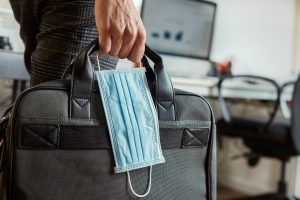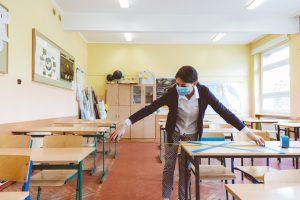What to do if there is a COVID outbreak in your workplace

As an employer, you will be as keen as anyone to do your bit in preventing an outbreak. Taking the necessary precautions will help you to avoid the costly disruption of an outbreak on your premises.
So what should you do if one of your staff develops symptoms? The first step is to send them home immediately. They should self-isolate for 10 days and members of their household or support bubble should do the same for 14 days.
After a symptomatic employee leaves the building, you are advised to clean the premises thoroughly. You should sanitise the workplace with disinfectant, paying particular attention to door handles, lift buttons, and other frequently touched areas.
Your employee will need to order a COVID-19 test by calling 119 or visiting the NHS website. If they test negative, they can return to work straight away. If they test positive, they must complete their 10-day isolation period.
They will be contacted by NHS Test and Trace who will ask for the details of anyone they had close contact with in the previous 48 hours. Some of these contacts are likely to be colleagues, so expect the Test and Trace team to tell more of your staff to self-isolate. If more than two lab-confirmed cases are linked to a particular setting, Public Health England (PHE) deem it an outbreak.
If a cluster of cases is identified in or around your workplace, the Health and Safety Executive (HSE) may wish to carry out an inspection, and PHE or an equivalent devolved body may investigate and offer specific support. This should be viewed as an offer of help rather than a punishment.
If the HSE identifies necessary changes, you will be given time and support to implement them. Although fines and closures can be imposed, this will only happen in cases of persistent non-compliance.
We are all resigned to COVID-19 being with us for some time. So review your risk assessments to ensure you are prepared for an outbreak. Employees should be consulted throughout this process and you should share the final version with them to gain their buy-in.
If you have any questions about COVID-19 safety, give us a call.
Returning to work: the risk of Legionnaires’ Disease

Also known as Legionella, Legionnaires’ is a bacterial lung infection caused by breathing in water droplets found in stagnant water. Symptoms of Legionella include coughs, muscle pain and even pneumonia. It can be fatal.
Since many workplaces were forced to close in a hurry, you may not have had time to consider water safety. That’s why it is especially important to carry out adequate checks before reopening. Although there are no specific laws regarding the control of Legionnaires’ Disease, you are likely to have a legal duty to take the necessary steps. The Legionnaire Control Association (LCA) says:
“Simply reopening a building that has stood idle, without addressing the safety of its water system, is unacceptable and is likely to be in breach of the law.”
We’d advise a risk assessment for all premises that were closed during the lockdown, especially those reinstating a water system or restarting an air conditioner. Checks can be performed by a competent person within your business or an external contractor. If you have more than five employees, you must also make a note of anyone who may be particularly vulnerable to Legionella, such as those with respiratory conditions.
Remember that some of the symptoms of Legionnaires’ and COVID-19 are similar, and an employee who appears to have Coronavirus may actually be suffering from Legionella.
Do your COVID-19 risk assessments include vulnerable staff?

Research shows that BAME (Black, Asian and Minority Ethnic) workers are disproportionately likely to die of COVID-19, especially if they work on the frontline of the NHS. One report showed that 75% of NHS workers who have died from the virus were from BAME backgrounds.
Yet long after this was known, it was reported that only 23% of NHS trusts had explicitly recognised this in their risk assessments. Many risk assessments also neglect to mention workers from other at-risk groups. These include older males, people with a high BMI, and people with underlying health conditions such as diabetes.
So when reviewing your risk assessments do acknowledge these discrepancies and set out measures to protect workers from vulnerable groups. It is not always obvious, so decide on how such people could be identified. These could include prioritising them for remote working, changing their tasks (within the scope of their contract), providing enhanced social distancing and hygiene measures in their vicinity, and making it clear that they can come to you with any concerns.
For help getting the nuance right in your risk assessment, give us a call.
What does the new school have in store?

With the government committed to a full reopening of schools in Autumn, this pressure will only increase. Class sizes will return to pre-COVID levels, allowing less room for social distancing. Parents will be concerned and it may fall on you to reassure them by communicating the processes you have in place.
While newly reopened businesses are encountering safety issues for the first time, you have been dealing with them for months. You don’t need us to tell you about the importance of handwashing or social distancing, but the unexpected can still occur. If you are affected by a new issue such as a local lockdown, don’t hesitate to ask us for advice.
Mythbusters

Throwing health and safety under the bus
Back in April, Colombia and Peru trialled lockdowns which permitted men and women to go out on alternate days. Both schemes proved unsuccessful and, fortunately, nothing similar was ever suggested in the UK!
But looking back through HSE myth buster cases we did see that a school bus company once cited health and safety laws as the reason for separating boys and girls on its buses. There is no such law, although bus drivers can separate pupils as they wish, in order to curb rowdy behaviour.
Health and safety or water cooler gossip?
A gym owner received a customer complaint about gym goers filling up their own bottles from the water cooler. The customer claimed that, for health and safety reasons, they should only use the paper cups provided.
At the time, there was no basis for this being a health and safety issue. Of course, we live in a very different world now. When gyms reopened on the 25 July, many had removed water coolers altogether to prevent the spread of germs.

